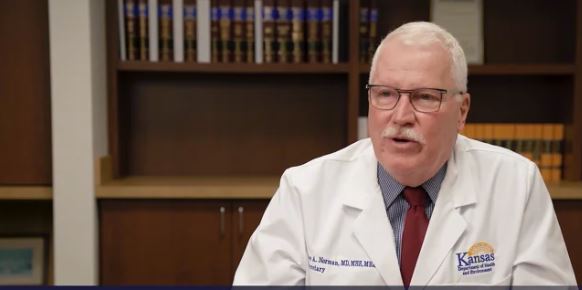By Tim Carpenter
Tribune News Service
TOPEKA — Dr. Lee Norman believes Kansas is nearing a coronavirus peak in terms of the toll exacted by the pandemic’s mysterious assailant.
Analysis of infection and fatality rates at the state Department of Health and Environment led to circling of late April on the calendar as the likely pinch point in Kansas.
This Rubik’s Cube of public health forecasting holds significance for Kansans eager for relief from this spiky dot of genetic material coated in fatty chemicals.
If testing in Kansas shows social distancing has sufficiently restrained spread of COVID-19, shackles of Gov. Laura Kelly’s executive orders binding the economy may be lifted May 3.
Norman, a physician and the KDHE secretary, said he was keen to get his hands on evidence of a steep 14-day decline in new infection.
“It’s not the absolute number of days and the number of cases. It’s the rapidity of the drop,” Norman said. “If it’s a very slow falling off, we’d be more concerned.”
On Tuesday, KDHE loosened rules on testing. No longer will people need to have an elevated temperature and exhibit two symptoms of the virus to get a test.
The temperature mandate was dropped as part of KDHE’s strategy to broadly test within the general population while staying up with testing demands at hospitals, communal residential spaces and hot spots, including meatpacking towns.
“It’s not a goal to test 3 million Kansans,” Norman said. “With targeted sampling, we estimated 15,500 tests to determine the prevalence of disease throughout the state of Kansas.”
Kelly said good news from the survey could lead to lifting of the statewide stay-at-home order, business-closure directive and mass-gathering restriction.
The governor warned that county officials would have authority to adopt new limits and a COVID-19 setback could prompt new state orders.
A flurry of infection in Garden City, Emporia and Dodge City where meatpacking plants are major employers may justify a type of regional approach to reopening the economy.
Transition to a new phase in the fight against a virus that has killed 107 and infected more than 2,000 in Kansas would be marked by substantial testing, rigorous contact tracing of potentially exposed people, isolation of virus carriers and treatment of the ill, she said.
The state needs help from the federal government with acquisition of testing supplies and equipment, the governor said. The state will assume responsibility for assembling the 400-person unit assigned to help track down people who might have been exposed to a person testing positive.
“These two items have to be solidly in place before we can actually think about opening the doors,” Kelly said.
U.S. Sens. Jerry Moran and Pat Roberts, both Kansas Republicans, voted for the new bipartisan relief package to clear the Senate. It requires an endorsement from the House and signature of President Donald Trump.
The legislation provides $25 billion for national coronavirus testing, including $21.2 for Kansas, and $75 billion for U.S. hospitals.
“Kansas is in desperate need of additional COVID-19 tests and this relief package will provide much-needed assistance to our state,” Moran said. “Through widespread testing, Kansans will be able to feel secure in their health so they can return to work and our economy can recover.”
Democrats held out for federal investment in testing and hospitals, but the deal didn’t include support for state and local governments suffering deep revenue losses.
Kelly said federal aid could help states such as Kansas, which is projected to miss out on $1.3 billion in tax revenue during the current and upcoming fiscal years.
The Senate bill met GOP demands for $310 billion to replenish the Paycheck Protection Program operated by the U.S. Small Business Administration. The first phase of PPP loans was snatched up by 1.6 million companies and prompted complaints from small business owners that they squeezed out of the $349 billion pot by large companies with more than 500 employees.
Moran said 26,000 Kansas businesses have so far benefited from PPP funding designed to help companies keep their employees on the payroll during the pandemic. The legislation also earmarked $60 billion in loans and grants for the SBA’s disaster relief fund and made farmers and other agriculture businesses eligible.
The House is expected to consider the bill Thursday. The president said on Twitter he would sign it into law.
“Two weeks ago, Republicans requested this additional funding for the Paycheck Protection Program,” said U.S. Rep. Ron Estes, the 4th District Republican. “Unfortunately, partisanship held up this much-needed relief.”
The Kansas Department of Labor completed computer tweaks necessary to implement a temporary 10-week increase the maximum amount of unemployment benefits.
The bill mandating a 26-week benefit was passed by legislators and signed by the governor in March. The labor department’s computer system has been overwhelmed by filing of more than 150,000 new jobless claims as COVID-19 muzzled companies and triggered layoffs and furloughs.
Delia Garcia, secretary of the labor department, said individuals filing for unemployment benefits on or after Jan. 1, 2020, would be eligible for the additional aid.
“If you are eligible, you will automatically receive the benefits extension,” she said. “You do not need an additional application.”
The agency is expected to complete this week’s computer modifications necessary to allocate to unemployed Kansans the $600 per week in bonus benefits approved by the federal government.

